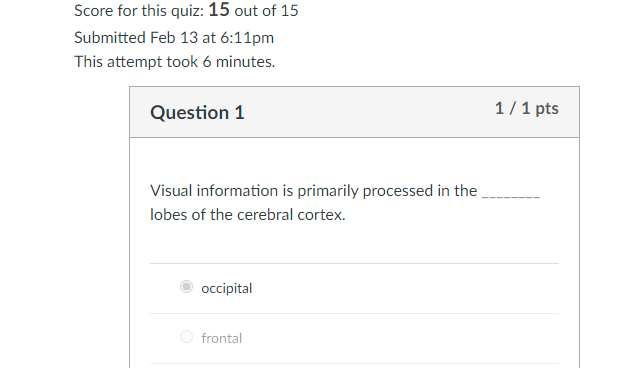Quiz #2 Biology & Psychology
Question 1
Visual information is primarily processed in the ________ lobes of the cerebral cortex.
occipital
frontal
temporal
parietal
Question 2
Jonas has experienced a relatively severe right hemisphere stroke. As a result, he has been diagnosed with hemineglect, meaning he is unable to notice any touch on the left side of his body. The location of the stroke was most likely within the lobes.
temporal
frontal
parietal
occipital
Question 3
Chemical substances that carry messages from one neuron to the next are called:
neurotransmitters.
antagonists.
agonists.
hormones.
Question 4
Brad has experienced a relatively severe left hemisphere stroke. As a result, he is unable to move his right arm and has a great deal of difficulty with planning and attention. The stroke most likely caused damage to the ________ lobes.
temporal
frontal
occipital
parietal
Question 5
Which of the following is NOT a modern method for accurately measuring brain activity?
an electroencephalograph
functional magnetic resonance imaging
transcranial magnetic stimulation
phrenology
Question 6
Which of the following phenomena would NOT be part of a study in behavioral genetics?
the effect of environmental and genetic interactions on psychological phenomena
the effect of genes on one’s environment
the effect of environmental and genetic interactions on biological phenomena
the effect of one environment on another environment
Question 7
Lisa has problems sleeping, so she goes to a sleep clinic. At the clinic the researchers measure her brain’s electrical activity as she sleeps by using the technique of:
transcranial magnetic stimulation (TMS).
phrenology.
electroencephalographs (EEGs).
functional magnetic resonance imaging (fMRI).
Question 8
The central nervous system is made up of the:
peripheral nervous system and the spinal cord.
somatic nervous system and the brain.
brain and spinal cord.
somatic and peripheral nervous systems.
Question 9
Which of the following best summarizes the main function(s) of your nervous system?
It regulates the oxygen in your blood, protects you from pain, and helps your body eliminate waste.
It produces vital bodily fluids such as bile and regulates the body’s secretion of these fluids.
It allows the right side of your brain to communicate with the left side of your brain.
It allows you to receive sensory information, process that information, and then respond to it.
Question 10
While he was heading home from work one day, Ibrahim was pulled over by a police officer. During the interaction, he was extremely stressed, causing his pulse to accelerate and his pulse and blood pressure to increase. Which neurotransmitter caused these physiological changes?
serotonin
acetylcholine
endorphins
norepinephrine
Question 11
The hypothalamus is a brain structure that is important in:
thinking.
regulating bodily functions.
regulating emotions.
synthesizing incoming information.
Question 12
During your lifetime, it is possible for your ________ to change.
phenotypes
genotypes
archetypes
taxonomic rank
Question 13
Because nicotine increases how the neurotransmitter acetylcholine functions, it is an
excitatory neurotransmitter.
inhibitory neurotransmitter.
agonist.
antagonist.
Question 14
The idea that the brain is extremely malleable and is continuously changing as a result of injury, experiences, or substances is known as:
plasticity.
myelination.
phenotype.
genetics.
Question 15
Regarding the factors potentially influencing behavior, which of the following statements is true?
Behavior is generated mainly by the endocrine system.
Behavior overwhelmingly reflects genetics.
Behavior mainly stems from environmental causes.
Behavior reflects an interaction between genetics and the environment.
Answer Preview-Quiz #2 Biology & Psychology

